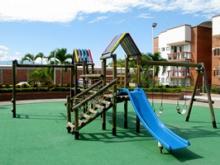
An urban area is an area with a high population density. Jersey City, New Jersey was reported to have the highest density of people per square mile at 13,043, according to the 2000 U. S. Census Bureau. American cities are rapidly growing with the top 50 metropolitan areas having a million or more people living in them. Americans living in urban areas currently number 79 percent of the population, and it is projected that by the year 2050 that percentage will rise to 90 percent. This demographic shift makes urban parks often the sole connection to the natural world for an increasing number of children who live in large cities.1
In the late 1880s a national reform movement began the playground movement, which was designed to protect children in the labor force and to promote supervised playgrounds, especially in immigrant ghetto areas.2 Municipal governments were urged to construct playgrounds where the city’s children could play under supervised conditions, believing that supervised play would improve the mental, moral, and physical well-being of children.3 The reformers felt that supervised playground activities would deter children from juvenile crime and give them moral purpose in their lives.4 Playgrounds were built in slum areas, and the inner city became the focus of philanthropists and local governments.5
By 1900 there were fourteen U. S. cities sponsoring playgrounds. Fifty-five cities had playground programs by 1910, and 113 colleges and universities were offering classes in recreation leadership to address the need to operate playgrounds effectively. Parks and recreation departments were developed that continued the responsibility of supervising playgrounds in the 1920s and 1930s. The role of the playground leader changed from supervisor to enabler during World War II, when it was discovered that children in urban areas in Western Europe created their own play space in bombed out areas in their neighborhoods, using whatever materials they could find. This led to the idea of adventure playgrounds in the United States where children could use their imagination to create their own play environments and play unsupervised.6
While children living in small towns and rural areas can freely enjoy playing outdoors unsupervised, children in urban areas often face many obstacles that hamper their opportunities to play outside. Busy parents have less time to supervise their children to allow outside play, and their concerns about safety and violence in their neighborhoods prohibit allowing them to freely play unsupervised. A lack of quality playgrounds with safe playground equipment is the result of decreased funding as well as poor urban planning. Children who live in poverty have fewer opportunities and lesser access to play facilities.7
Dr. Joe Frost, a leading expert on play, identified many factors that have resulted in deprivation of free, urban, spontaneous outdoor play. These factors include lack of trained adult leaders in parks, lack of ready access to outdoor play areas, fear for children’s safety, and excessive safety standards for playground equipment and lawsuits. Other factors include the emphasis on standardized testing in schools as well as the many hours children spend on electronic media, video games, computers, and television, which keeps them inside.8
Successful urban playground programs are offered by many different entities, including parks departments, community centers, public housing developments, and churches. Well-planned and organized programs offer children opportunities for a variety of activities as well as supervised play on safe playground equipment. Summer playground programs provide hours of activities and games that develop children’s physical and social skills in a supervised, safe setting.9
- 1. Lindstrom, Lane. “Keeping Urban Play In Your City.” Playground Magazine. Fall 2010. p. 10-11.
- 2. “Early History of Playgrounds in the United States.” Outdoor Fun Store Co. < http://www.outdoorfunstore.com/playground-history.asp > 10 Dec. 2010.
- 3. Bachrach, Julia Sniderman. “Playground Movement.” Encyclopedia of Chicago. < http://www.encyclopedia.chicagohistory.org/pages/976.html > 10 Dec. 2010.
- 4. Patton, L. Pettis. “Urban playgrounds: an institution of learning for children – Cover Story.” Parks & Recreation. FindArticles.com. < http://findarticles.com/p/articles/mi_m1145/is_nr_v31/ai_18238601/ > 10 Dec. 2010.
- 5. Op. cit., “Early History of Playgrounds in the United States.”
- 6. Dickason, Jerry G. “Playground Movement.” Encyclopedia of Children and Childhood in History and Society. faqs.org. < http://www.faqs.org/childhood/Pa-Re/Playground-Movement.html > 10 Dec. 2010.
- 7. Op. cit., Lindstrom, Lane.
- 8. Op. cit., Lindstrom, Lane.
- 9. Op. cit., Patton, L. Pettis.

